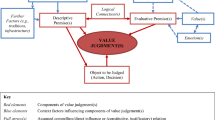Abstract
What is the relationship between biotechnology employees’ beliefs about the moral outcomes of a controversial transgenic research project and their attitudes of acceptance towards the project? To answer this question, employees (n=466) of a New Zealand company, AgResearch Ltd., were surveyed regarding a project to create transgenic cattle containing a synthetic copy of the human myelin basic protein gene (hMBP). Although diversity existed amongst employees’ attitudes of acceptance, they were generally: in favor of the project, believed that it should be allowed to proceed to completion, and that it is acceptable to use transgenic cattle to produce medicines for humans. These three items were aggregated to form a project acceptance score. Scales were developed to measure respondents’ beliefs about the moral outcomes of the project for identified stakeholders in terms of the four principles of common morality (benefit, non-harm, justice, and autonomy). These data were statistically aggregated into an Ethical Valence Matrix for the project. The respondents’ project Ethical Valence Scores correlated significantly with their project acceptance scores (r=0.64, p<0.001), accounting for 41% of the variance in respondents’ acceptance attitudes. Of the four principles, non-harm had the strongest correlation with attitude to the project (r=0.59), followed by benefit and justice (both r=0.54), then autonomy (r=0.44). These results indicate that beliefs about the moral outcomes of a research project, in terms of the four principles approach, are strongly related to, and may be significant determinants of, attitudes to the research project. This suggests that, for employees of a biotechnology organization, ethical reasoning could be a central mechanism for the evaluation of the acceptability of a project. We propose that the Ethical Valence Matrix may be used as a tool to measure ethical attitudes towards controversial issues, providing a metric for comparison of perceived ethical consequences for multiple stakeholder groups and for the evaluation and comparison of the ethical consequences of competing alternative issues or projects. The tool could be used to measure both public and special interest groups’ ethical attitudes and results used for the development of socially responsible policy or by science organizations as a democratizing decision aid to selection amongst projects competing for scarce research funds.
Similar content being viewed by others
References
T. L. Beauchamp J. F. Childress (1994) Principles of Biomedical Ethic Oxford University Press Oxford
M. Corrado K. Pooni Y. Hartfree (2001) The Role of Scientists in Public Debate Market and Opinion Research International (MORI) London
J. Cohen (1988) Statistical Power Analysis for the Behavioural Sciences EditionNumber2 L Erlbaum Associates Hillsdale, NJ
M. Fisher B. Small H. Roth M. Mallon B. Jerebine (2005) ArticleTitleWhat Do Individuals in Different Science Groups Within a Life Sciences Organization Think About Genetic Engineering? Public Understanding of Science 14 317–326 Occurrence Handle10.1177/0963662505048594
B. Knox (2000) ArticleTitleConsumer Perception and Understanding of Risk From Food British Medical Bulletin 56 IssueID1 97–109 Occurrence Handle10.1258/0007142001903003 Occurrence Handle10885108
T. B. Mepham (1996) Ethical Analysis of Food Biotechnologies: An Evaluative Framework T. B. Mepham (Eds) Food Ethics Routledge London 101–119
T. B. Mepham (2000) ArticleTitleA Framework for the Ethical Analysis of Novel Foods: The Ethical Matrix Journal of Agricultural and Environmental Ethics 12 165–176 Occurrence Handle10.1023/A:1009542714497
H. Simon (1982) Models of Bounded Rationality MIT Press Cambridge, Mass
B. H. Small J. A. Wilson J. A. Pedersen T. G. Parminter (2002) ArticleTitleGenetic Engineering and the Public: Attitudes, Beliefs, Ethics and Cows Proceedings of the New Zealand Society of Animal Production 62 179–182
Author information
Authors and Affiliations
Corresponding author
Rights and permissions
About this article
Cite this article
Small, B.H., Fisher, M.W. Measuring Biotechnology Employees’ Ethical Attitudes towards a Controversial Transgenic Cattle Project: The Ethical Valence Matrix . J Agric Environ Ethics 18, 495–508 (2005). https://doi.org/10.1007/s10806-005-0904-z
Accepted:
Issue Date:
DOI: https://doi.org/10.1007/s10806-005-0904-z




